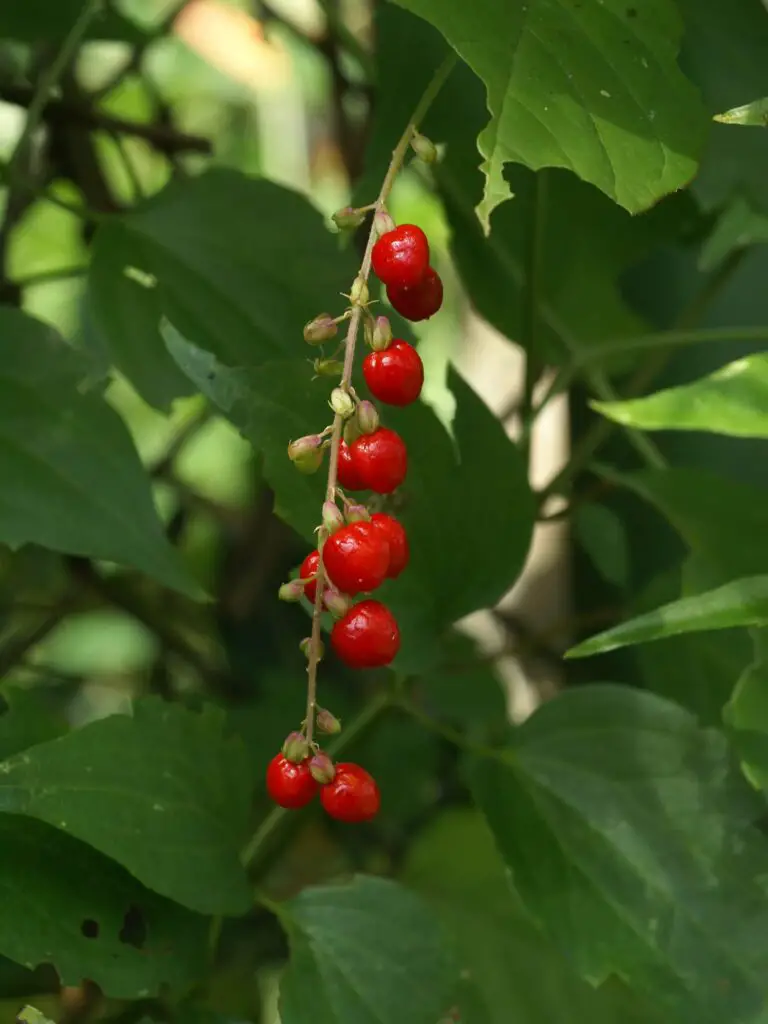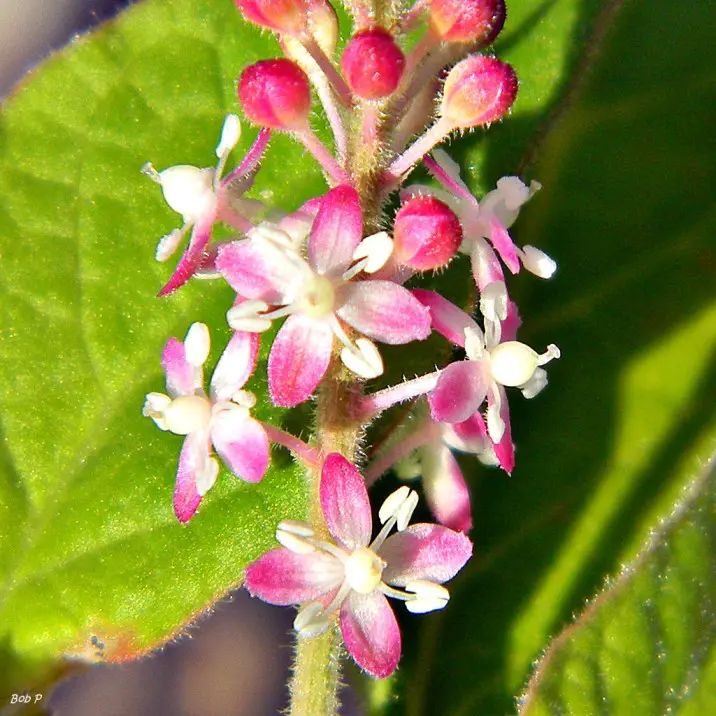Scientifically known as Rivina Humilis, and commonly known as rouge plant, bloodberry, baby peppers, and the Pigeonberry. It is a plant that can cover the area beneath the trees and big plants, where there is a partial shade. This plant has beautiful flowers and fruits too. It can even attract wild birds to your home garden that’s why it’s named the pigeon berry.
If you want to grow this plant in your home garden then you are in the right place as we are going to discuss in detail how to plant pigeonberry.

Pigeonberry Plants
Pigeonberry is a small plant, which is native to Texas. It is planted in USDA hardiness zones from 7 to 10, and also many other parts of the world. This is a small shrub, which is usually used as cover for gardens, but also used as a boundary for the gardens.
Pigeonberries don’t grow high enough. It only grows up to 1 and a half to 2 feet high. Its white and pinkish flowers make it more attractive. People use it for ground covering, it is very commonly used for this purpose.
One of its qualities makes it favored for nature-loving people. That is blooming and fruiting at the same time for a longer period. It can bloom and have fruit from summer till the fall. The berries this plant is going to produce will be inviting new guests to your garden and you need to get ready to welcome them.
Are Pigeonberries poisonous?
On the other hand, its leaves and fruits are not edible for pets and human beings as well. You need to take care because its fruits are toxic. Birds can eat it. So you need to worry as they’ve got no problem regarding this toxicity. They can handle this. If you have curious pets or children, be careful about it.
Why Pigeonberry Plants?
Where does Pigeonberry grow?
First and foremost, it is a very common misconception among people that nothing can grow under the shade of big plants or trees. But the pigeon berry is here to debunk this myth. It can grow very well under the shades or the partial shades of the trees.
This will not only cover the ground which is not possible to cover by planting any shrub or tree but its flowers and fruits will make the place attractive and it will provide a cool sight for the eyes. It will also attract wild birds and pollination insects which will result in increased pollination.
Alongside being planted in shade to cover the ground, this plant can also be used for the small boundaries inside the garden or as the main boundary for the garden. As it grows not more than 2 feet high, it presents a beautiful view, when it is blooming and fruiting.
Moreover, this is most of the time being planted at shiny shady places, it doesn’t need much water once it is being established. You have to water it in times of droughts and harsh summers. But it can survive in the sunshine also. Once established it is good to go.
How to Plant Pigeonberries Plants
Pigeonberry is grown from seeds. Some people have tried its propagation through cuttings or stems, but that was not very successful. So, you need to plant this shrub, by getting the seeds and then going through all the processes of germination, transplanting, and care.
Keep the season in mind. You have to sow the seeds after the last frost of the winter has passed. Then you can get the seeds and start sowing them.
Getting Seeds of Pigeonberry Plants
You can get the seeds from any horticulture point or a trusted online plant store, as it is native to the US it is available all the way. One other trick is also possible. You can collect the berries of the pigeonberry plants. Then you need to get them dry to get the pigeonberry seeds out of them.
Once you have got the seeds, carefully clean them and start the selection phase. If any seed is not looking good or is injured, you need to remove it. This process will help in a high germination rate because it will minimize the chances of seeds not germinating.
Sowing the Pigeonberry Seeds
Now as you have got the seeds, you have to prepare the pot or a container where you have to sow those seeds. Get the container that suits you best and fill the soil inside it. Keep in mind the soil should be sandy loam, clay, or calcareous.
When the mixture is inside the pot, moisten the soil with spraying water or pouring water. Keep the upper layer of soil loosened. Then sow the seeds inside it. Sow the seeds about 5mm deep. Cover the seeds with a mixture of soil and water the soil to keep up with the moisture.
Once seeds have started germinating, keep them watering to have enough moisture. Then take away any weeds and also the weak plants. This will provide space and nutrients for healthy plants.
Transplanting the Pigeonberry Plants
Before transplantation of plants, you would like to look for a proper location to plant the pigeon berry. As mentioned earlier, you can plant in partial shade or full sun also, but you need to take care of water in the second case.
Now as the stem of the newly germinated plants has been developed, it is time to transplant the plants to the final location. First of all, get the place ready. Till the place well and get any weeds out. Now you have to dig the holes deep enough to cover the root balls of the plants.
Soil Preparation for Pigeonberry
Make sure the soil is well-drained because excess water might cause problems for the plant. You have to mix the compost into the soil, before planting the seedlings there. So, mix the soil in advance. Provide the soil with enough water to keep it moist. The pH of the soil should range from 6.1 to 7.8.
Now as all the necessary things are ready, take the pigeonberry plants out from the container carefully. Make sure the root ball is intact and not broken. Now you can put it in the hole already dug and pour the mixture of the soil to fill the hole. Gently press the soil around the stem of the plant.
After plantation has been done, now water the plant so that roots can get enough water.
Taking Care of Pigeon Berry Plants

Taking care of this plant is not very difficult. You have to just make sure of the availability of basic necessities for the plants. This plant needs little or no care once it is established.
Watering the Pigeonberry Plants
Watering is important for all plants. The Pigeonberry plant is no exception. You just need to make sure that plant is getting enough water, especially in the first year. You can make the schedule of watering these plants. It is necessary to water every week to keep up with the required moisture.
In the drought or the harsh summer weather, you need to increase the frequency of watering the plants. Make sure they are not hit by the drought. Because drought can take them to dormancy. These plants will take time to bloom again.
Pruning the Pigeonberry Plants
Although not necessary, pruning can be done for this plant. It gives resistance to pests and diseases. Also, it helps in keeping the proper shape of the plant. You can prune pigeonberries once they are established and grown enough.
You can prune it to any shape you want. Make sure that no more than one-third of the plant is being pruned. Those branches which are pruned once, shouldn’t be pruned for the next time.
If your plant goes into the dormant stage meaning it is not evergreen, you can cut the plant a few inches above the ground. This will help in retaining nutrients and blooming well in summers.
Pests and Diseases of Pigeonberries
There are no common known pests and diseases for pigeonberry plants. However, if any of the pests attack the plant get the proper consultancy from nearby horticulturists. The diseases and pests are rare in the case of pigeonberries.
Companion Plants of Pigeonberries
As this plant is grown in shades, or the partial shades of the other plants it is good to know about the companion plants of Pigeonberry. These plants are usually good with all of the big trees, but the common ones are Turk Cap, Sea Oats, Frostweed, Beautyberry, and Cedar Sage.
You can say this plant is a full package not only of nature’s aspect of gardening but also of other aspects as well. It attracts songbirds and also presents a good view of bloom and fruiting.
In a nutshell, this plant fulfills the requirement of every nature-loving gardener. It might result in getting you new birds which will increase the beauty of the garden with their presence and beautiful chirping.
You May Also Like
How to Plant Pyracantha from Seeds
References

